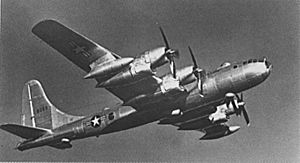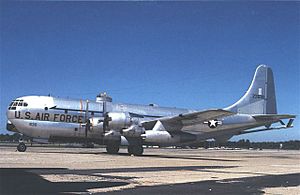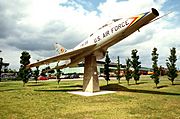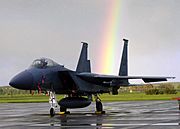RAF Lakenheath facts for kids
Quick facts for kids RAF Lakenheath
|
|||||||
|---|---|---|---|---|---|---|---|
| Near Eriswell, Suffolk in England | |||||||

Boeing F-15E Strike Eagles of the 48th Fighter Wing taxiing at Lakenheath.
|
|||||||
 |
|||||||
|
Shown within Suffolk
|
|||||||
| Coordinates | 52°24′30″N 000°33′24″E / 52.40833°N 0.55667°E | ||||||
| Type | RAF station (US Visiting Forces) | ||||||
| Code | LN | ||||||
| Area | 727 hectares | ||||||
| Site information | |||||||
| Owner | Ministry of Defence | ||||||
| Operator | United States Air Force | ||||||
| Controlled by | United States Air Forces in Europe - Air Forces Africa (USAFE-AFAFRICA) | ||||||
| Condition | Operational | ||||||
| Site history | |||||||
| Built | 1940 | ||||||
| In use | 1941 – 1948 (Royal Air Force) 1948 – present (US Air Force) |
||||||
| Garrison information | |||||||
| Garrison | 48th Fighter Wing | ||||||
| Occupants |
|
||||||
| Airfield information | |||||||
| Identifiers | IATA: LKZ, ICAO: EGUL, WMO: 03583 | ||||||
| Elevation | 10 metres (33 ft) AMSL | ||||||
|
|||||||
Royal Air Force Lakenheath, or RAF Lakenheath, is a Royal Air Force base in Suffolk, England. It is near the village of Lakenheath. The base is about 4.7 miles (7.6 km) north-east of Mildenhall.
Even though it is an RAF station, RAF Lakenheath is currently home to only United States Air Force (USAF) units. The main group there is the 48th Fighter Wing, also called the Liberty Wing. This wing flies F-15E Strike Eagle and F-35A Lightning II jets.
Contents
History of RAF Lakenheath
World War I Beginnings
The land where Lakenheath is now was first used as an airfield during World War I. It was a practice area for planes from the Royal Flying Corps. They used it for bombing and ground attacks. After the war ended in 1918, the site was no longer used.
World War II and RAF Use
A Decoy Airfield
In 1940, the Air Ministry chose Lakenheath as a backup for RAF Mildenhall. It was used as a decoy airfield. Fake lights, runways, and planes were set up to trick Luftwaffe attackers away from Mildenhall.
In 1941, proper runways were built. The main runway was 2,000 yards (1,829 m) long. Hangars were also built for aircraft.
RAF Squadrons at Lakenheath
RAF flying units started using Lakenheath in late 1941. It became a satellite base for Mildenhall. No. 149 Squadron RAF moved its Short Stirling bombers there in April 1942. They flew many missions, including laying mines. The squadron moved away in mid-1944.
In 1943, more hangars were built for storing gliders. About 40 Horsa Gliders were kept at Lakenheath.
No. 199 Squadron RAF was formed in June 1943. They also flew Stirling bombers and laid mines. This squadron moved to another base in May 1944.
Upgrading for Heavy Bombers
Lakenheath was chosen to become a base for very heavy bombers. This meant building new, stronger runways. The main runway became 3,000 yards (2,743 m) long. Part of a nearby road had to be closed and rebuilt. Over 1,000 workers were on site during the busiest time. The work took 18 months for the runways alone. The total cost was almost £2 million.
By the time the construction finished, World War II was over. RAF Lakenheath was then put on standby.
United States Air Force Era
Cold War and Strategic Air Command
After World War II, tensions grew between the US and the Soviet Union. This period was called the Cold War. In 1948, Strategic Air Command (SAC) B-29 bombers came to Lakenheath. This was part of a plan to have US strategic air power in Europe.
In November 1948, the United States Air Force (USAF) took control of RAF Lakenheath. The base became a key location for SAC in the UK. By 1950, Lakenheath was one of three main SAC bases in England.
Different types of bombers came through Lakenheath. The B-29s were replaced by B-50 Superfortresses. Then, in 1954, B-47 Stratojets arrived.
In 1956, two Lockheed U-2 spy planes were brought to Lakenheath. They were part of a secret Central Intelligence Agency unit. They flew their first mission from Lakenheath in May 1956.
Aircraft Incidents
On July 27, 1956, a B-47 bomber crashed into a storage building at Lakenheath. The building held three large bombs. Luckily, the bombs did not explode. Four crew members were killed in the crash.
Later, on October 10, 1956, a US Navy transport plane disappeared. It had taken off from RAF Lakenheath. All 59 people on board were lost over the Atlantic Ocean.
The 48th Fighter Wing Arrives
In 1960, the 48th Tactical Fighter Wing moved to Lakenheath. They flew North American F-100 jets. This move brought the "Statue of Liberty Wing" back to England. The 48th Fighter Wing had been in England during World War II.
The 48th TFW had three main fighter squadrons:
- 492d Fighter Squadron
- 493d Fighter Squadron
- 494th Fighter Squadron
In the early 1970s, the 48th TFW changed its aircraft. They started flying McDonnell Douglas F-4D Phantom II jets. The last F-100 left in 1974.
The F-4s did not stay long. In 1977, the 48th TFW received General Dynamics F-111 jets. A fourth squadron, the 495th Tactical Fighter Squadron, was added. This squadron trained pilots for the other three.
Operation Against Libya
F-111s from the 48th TFW took part in a bombing mission against Libya in 1986. During this operation, one F-111 from Lakenheath was shot down. Both crew members were killed.
Modern Jets Arrive
Lakenheath received its first F-15E Strike Eagles in 1992. As the F-111s left, the 495th FS was closed down. The last F-111 left the base in December 1992.
In 1994, the 493d squadron was reactivated. It became an F-15C/D squadron. This made the 48th the largest F-15E/F-15C unit in the US Air Force.
In 2003, the 48th FW received more new F-15Es. These were some of the last F-15s ordered by the Air Force.
There have been a few aircraft incidents since then. In 2011, an F-15E crashed in Libya due to a mechanical problem. Both pilots safely ejected. In 2014, an F-15D crashed during a training flight in England. The pilot also ejected safely.
Units at RAF Lakenheath
Here are some of the main units based at RAF Lakenheath:
United States Air Force
United States Air Forces in Europe - Air Forces Africa (USAFE-AFAFRICA)
- 48th Fighter Wing
- 48th Operations Group
- 48th Operations Support Squadron
- 492nd Fighter Squadron – Flies F-15E Strike Eagle jets
- 493rd Fighter Squadron – Flies F-35A Lightning II jets
- 494th Fighter Squadron – Flies F-15E Strike Eagle jets
- 495th Fighter Squadron – Flies F-35A Lightning II jets
- 48th Maintenance Group (handles aircraft repairs and upkeep)
- 48th Medical Group (provides healthcare)
- 48th Mission Support Group (supports the base operations)
- 48th Operations Group
The base also has about 1,500 British and US civilian staff.
Nuclear Weapons at Lakenheath
While never officially confirmed, US nuclear weapons were believed to be at Lakenheath from the 1950s until the 1990s. As of 2024, no US nuclear weapons are known to be based in the UK.
Base Heritage
Gate Guardian Aircraft
RAF Lakenheath has a special aircraft displayed at its entrance. This is a North American F-100D Super Sabre jet. It is painted to look like a plane that flew with the 48th Fighter Wing.
Protests at the Base
RAF Lakenheath has often been the site of peace protests. Groups like the Stop the War Coalition and the Campaign for Nuclear Disarmament have held demonstrations there.
Pershing Missile Protests
Lakenheath was once considered a site for Pershing II Missiles. This led to many protests across Europe. A "peace camp" was even set up outside RAF Lakenheath. In 1985, Rowan Williams, who later became the Archbishop of Canterbury, was arrested during a protest there.
Libya Bombing Protests
Over 1,000 people protested outside RAF Lakenheath in 1986. This was after the base was used in the bombing of Libya.

Iraq War Protests
The 2003 invasion of Iraq also led to new protests. In one event, nine protesters got onto the base by cutting a fence. They rode bicycles on the main runway before chaining themselves together.
Activists later set up another "peace camp" outside the base. In 2006, about 200 people protested about the nuclear weapons believed to be stored at Lakenheath. Jeremy Corbyn, a politician, spoke at this protest. More protests happened in 2008.
Images for kids
See also
 In Spanish: Base Aérea de RAF Lakenheath para niños
In Spanish: Base Aérea de RAF Lakenheath para niños
















